DDR3 vs DDR4 vs LPDDR4 Comparison: Two essential elements in the world of electronics raw performance and efficient power consumption are in constant conflict. When it comes to memory, the temporary storage that keeps your gadget operating properly, this conflict is particularly visible.
We’ll examine the distinctions between LPDDR (Low Power Double Data Rate) and DDR (Double Data Rate) memory today, highlighting their advantages and disadvantages so you can decide which is better for your needs.
This blog will explain these two memory technologies, whether you’re a tech enthusiast trying to maximize your desktop computer or an enthusiastic mobile user hoping to learn more about the inner workings of your smartphone.
In the end, we’ll help you gain a deeper grasp of the memory that powers your favourite gadgets by going over their fundamental features, performance standards, and power efficiency.
Now without further ado, let’s compare DDR3 to DDR4 to LPDDR!
What is Low Power Double Data Rate 4 (LPDDR4)
Low Power Double Data Rate 4, or LPDDR4, is a kind of synchronous dynamic random-access memory (SDRAM) that is mostly found in laptops, tablets, and smartphones, among other mobile devices.
LPDDR4 provides notable enhancements over its predecessors concerning bandwidth, speed, and power efficiency.
The single-channel chip used in LPDDR3 was replaced in LPDDR4 with a two-channel die that has 32 bits total, 16 bits for each channel.
The operational speed of the core is increased and its power consumption is decreased due to the shorter data paths. Although it may be set up in a dual-channel topology to obtain noticeably greater rates, the maximum bandwidth per die is 17 GB/s.
Samsung declared on December 30, 2013, that it had created the first 20 nm-class 8 gigabit (1 GB) LPDDR4 that could transfer data at 3,200 MT/s. This meant that it could transmit data 50% faster than the fastest LPDDR3 while using about 40% less energy at 1.1 volts.
LPDDR has the benefit of being extremely efficient at consuming less energy when the end device isn’t using the memory. Because the low-power standard operates at a lower frequency than DDR, it is easier to instantly throttle performance up or down.
To save even more power, LPDDR5 DRAM employs dynamic voltage scaling or DVS. The memory controller can now lower the DRAM’s voltage and frequency while it’s in channel standby.
LPDDR DRAM channels are often 16-bit or 32-bit wide in comparison to regular normal DDR DRAM channels, which are 64-bit wide.
LPDDR4 can support one, two, or four channels; the data path length is shortened for dual channels. Instead of utilizing a single channel to obtain all 32 bits of data, we employ two channels, each of which returns 16 bits of data.
Key features of LPDDR4:
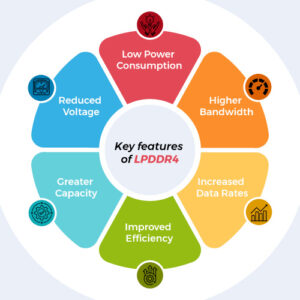
- Low Power Consumption: LPDDR4 is perfect for battery-powered devices because it is made to use less power than earlier versions. Process technology innovations and architectural optimizations help achieve this.
- Higher Bandwidth: In comparison to LPDDR3, LPDDR4 offers better data transfer rates, which facilitates quicker data access and enhanced system performance.
- Increased Data Rates: Higher data speeds are supported by LPDDR4, which means that the processor and memory may communicate more quickly. This makes device responsiveness and multitasking more seamless.
- Improved Efficiency: With features like on-die termination (ODT), which lowers reflections in signals and enhances signal integrity, LPDDR4 provides higher overall efficiency.
- Greater Capacity: In comparison to earlier generations, LPDDR4 enables higher memory capacity, meeting the increasing demands of modern operating systems and applications.
- Reduced Voltage: In addition to operating at a lower voltage than LPDDR3, LPDDR4 has higher power efficiency.
As a result, LPDDR4 is ideally suited for a variety of mobile and embedded applications where battery life and performance are critical considerations since it provides a balance between power efficiency and performance.
LPDDR3
The JEDEC Solid State Technology Association formally announced the standard specification for the third-generation low-power memory technology, or LPDDR3, in May 2012. Additionally, PoP stacked packaging and independent packaging are supported by LPDDR3 to accommodate various mobile device kinds. Additionally, the LPDDR2 signal interface and energy-saving features have been maintained.
LPDDR3 delivers more bandwidth, higher data rates, better power economy, and more memory density than LPDDR2. LPDDR3 uses three important new technologies—low-I/O capacitance, optional on-die termination (ODT), write-leveling, and command/address training—to produce a data rate of 1600 MT/s. Package-on-package (PoP) and discrete packaging formats are supported by LPDDR3.
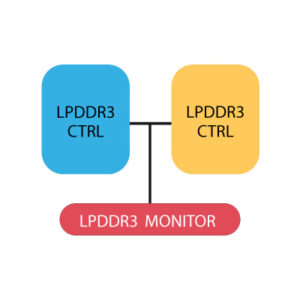
What is Double Data Rate 3 (DDR3)
Double Data Rate 3 (DDR3) is a form of synchronous dynamic random-access memory (SDRAM) that was introduced in 2007 and replaces DDR2 with a high bandwidth (“double data rate”) interface. It was extensively utilized in a wide range of computing devices, including servers, laptops, desktop computers, and some mobile devices, before being replaced by DDR4 and DDR5.
DDR3 offers faster data transfer rates, which lets your computer read and write data faster. This enhances system performance overall, particularly when using memory-intensive programs like video editing software or games.
The ability of DDR3 SDRAM to transfer data at double the data rate (eight times the speed of its internal memory arrays) over its direct predecessor DDR2 SDRAM is its main advantage over the latter. This allows for larger bandwidth or peak data rates.
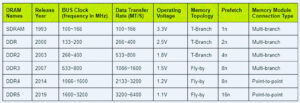
Key features of DDR3 memory:
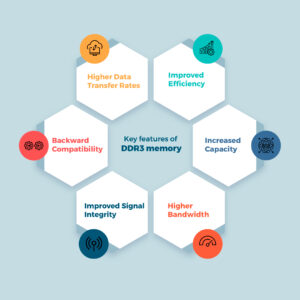
- Higher Data Transfer Rates: Higher data transfer speeds are provided by DDR3 than by DDR2, which enables quicker data access and better system performance.
- Improved Efficiency: Advances in semiconductor technology and architectural optimizations allow DDR3 memory modules to function at lower power consumption than DDR2 memory modules.
- Increased Capacity: Higher memory capacities are supported by DDR3 than by DDR2, allowing systems to manage workloads and applications that are more demanding.
- Higher Bandwidth: Faster data transfer between the memory and the processor is made possible by DDR3’s higher memory bandwidth as compared to DDR2.
- Improved Signal Integrity: To enhance signal integrity and lower data transmission mistakes, DDR3 includes technologies like dynamic ODT and On-Die Termination (ODT).
- Backward Compatibility: Although DDR3 memory modules function at DDR2 speeds when put in DDR2 slots, they are backward compatible with DDR2 slots.
The enhanced performance, efficiency, and capacity of DDR3 over earlier generations of DDR memory have led to its widespread adoption across a variety of computing platforms. On the other hand, since more advanced computer systems demand greater performance and efficiency standards, DDR4 and DDR5 memory technologies have been progressively replacing them.
What is Double Data Rate (DDR4)?
The fourth generation of synchronous dynamic random-access memory (SDRAM) technology is called DDR4 (Double Data Rate 4), and it comes after DDR3. When compared to DDR3, DDR4 memory modules have several advantages in terms of capacity, power efficiency, and performance.
The first DDR4 memory console was produced by Samsung in 2011, and the technology was available to consumers in 2014. Though the focus is primarily on external hardware, improvements such as this new memory technology are what make computers possible.
Higher module density, lower voltage needs, and faster data rate transfers are the main benefits of DDR4 over its predecessor, DDR3. Whereas DDR3 only permitted a maximum of 16 GB per DIMM, the DDR4 standard supports DIMMs with a capacity of up to 64 GB.
DDR4 modules use less energy than DDR3 modules since they operate at 1.2V as opposed to 1.5V or 1.35V for DDR3. Significant power savings result from the lower power consumption, which also enables faster operation without increasing the need for cooling or power.
Key features of DDR4:
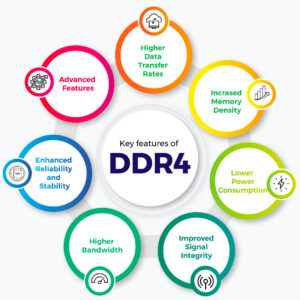
- Higher Data Transfer Rates: Higher data transfer rates are offered by DDR4 memory modules than by DDR3 memory modules, enabling quicker data access and better system responsiveness.
- Increased Memory Density: Higher memory densities are supported by DDR4, allowing systems to hold more RAM. For workloads and applications that require a lot of memory, this is very advantageous.
- Lower Power Consumption: DDR4 has higher power efficiency since it runs at a lower voltage than DDR3. DDR4 is perfect for mobile devices and energy-efficient computing systems because it lowers the overall power consumption of the system.
- Improved Signal Integrity: On-die termination (ODT) and data bus inversion (DBI), two improvements included in DDR4, serve to reduce data transmission mistakes and increase signal integrity.
- Higher Bandwidth: More bandwidth is available in DDR4 memory than in DDR3, which enables quicker data transfer between the memory and the processor. Overall system performance improves as a result, particularly for memory-intensive applications.
- Enhanced Reliability and Stability: The enhanced error detection and correction capabilities of DDR4 memory modules contribute to increased system stability and Reliability.
- Advanced Features: DDR4 further improves overall performance and economy by introducing new features like enhanced refresh mechanisms, longer burst lengths, and support for higher-speed connections.
For modern computing systems, such as servers, high-performance workstations, laptops, and desktop computers, DDR4 memory technology has become the norm. In terms of performance, efficiency, and scalability, it provides a notable boost over DDR3 to satisfy the needs of modern computing requirements.
DDR3 Vs DDR4 Vs LPDDR4
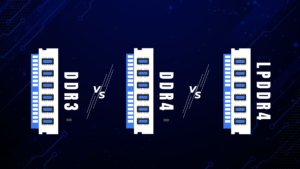
Examining the main distinctions between DDR3, DDR4, and LPDDR4 in terms of usage situations, power efficiency, and performance is necessary.
Here’s a comparative overview:
Performance:
- DDR3: In comparison to DDR4 and LPDDR4, DDR3 has lower data transmission rates. Typically, it runs between 800 MHz and 2133 MHz in terms of frequency.
- DDR4: Compared to DDR3, DDR4 offers faster data transfer rates, with speeds reaching up to 4800 MHz and beyond. The overall performance of the system is enhanced as a result.
- LPDDR4: While LPDDR4 is designed for low power consumption, it offers performance levels that are comparable to those of DDR4. Usually, it runs between 1600 and 4266 MHz in frequency range.
Power Efficiency:
- DDR3: DDR3 uses more energy than LPDDR4 and DDR4. It is less effective for battery-powered devices because it runs at greater voltages.
- DDR4: Compared to DDR3, DDR4 uses less power. Particularly in situations where there is little or no demand, it uses less power because it runs at lower voltages.
- LPDDR4: Due to its low power consumption design, LPDDR4 is perfect for mobile devices like tablets and smartphones. Compared to DDR3 and DDR4, it provides notable power savings that allow for extended battery life.
Usage Scenarios:
- DDR3: Desktop PCs, laptops, and outdated servers are frequently found to contain DDR3. While some legacy systems continue to use it, DDR4 is rapidly replacing it.
- DDR4: The typical memory technology for contemporary computing devices, such as servers, high-performance workstations, laptops, and desktops, is DDR4. In comparison to DDR3, it provides better performance and efficiency.
- LPDDR4: Primary applications for LPDDR4 include ultraportable computers, tablets, and smartphones where battery life is an important consideration. Without sacrificing performance, it allows for longer battery life.
Space Consumption:
- DDR3: DDR3 SDRAM is a faster and more power-efficient version of DDR2 Space Memory. Our Radiation Tolerant DDR3 SDRAM memories are arranged as x16b, x48b, or x72b and come with a 1.35 V or 1.5 V power supply. They range in capacity from 16 GB to 24 GB.
- DDR4: Compared to DDR3 SDRAM, DDR4 SDRAM has faster speed and less usage. Radiation-Tolerant DDR4 SDRAM modules with a 1.2 V power supply are arranged in x48b or x72b groups, ranging in capacity from 16 Gb to 64 Gb.
- LPDDR4: DDR4 memory’s mobile equivalent is called LPDDR4 (Low Power DDR4). It provides lower power consumption than DDR4, albeit at the expense of bandwidth. Due to its two 16-bit channels, LPDDR4 has a 32-bit total bus.

Conclusion
In conclusion, DDR4 is the recommended option for common computing systems since it provides better power economy and performance than DDR3.
LPDDR4, on the other hand, is frequently seen in mobile devices that run on batteries and places a higher priority on power efficiency than sheer performance.
Every memory type is tailored to meet the unique requirements of various computing platforms and is optimized for particular usage scenarios.
For desktops and the majority of laptops, DDR4 is the greatest option because it provides the optimal speed and efficiency for daily tasks.
Its superior performance over DDR3 makes it the obvious choice for today’s computing requirements. DDR4 is the best option if you’re upgrading an old system or creating a new one.
In terms of mobile devices, LPDDR4 is superior. Your smartphone or tablet will run longer if you prioritize battery life above raw power. Even though DDR4 performs better, its increased power consumption makes it impractical for these small devices.
The type of RAM ultimately relies on your device and priorities: LPDDR4 is recommended for mobile devices where battery life is critical, whereas DDR4 is recommended for performance-focused desktops and laptops.








